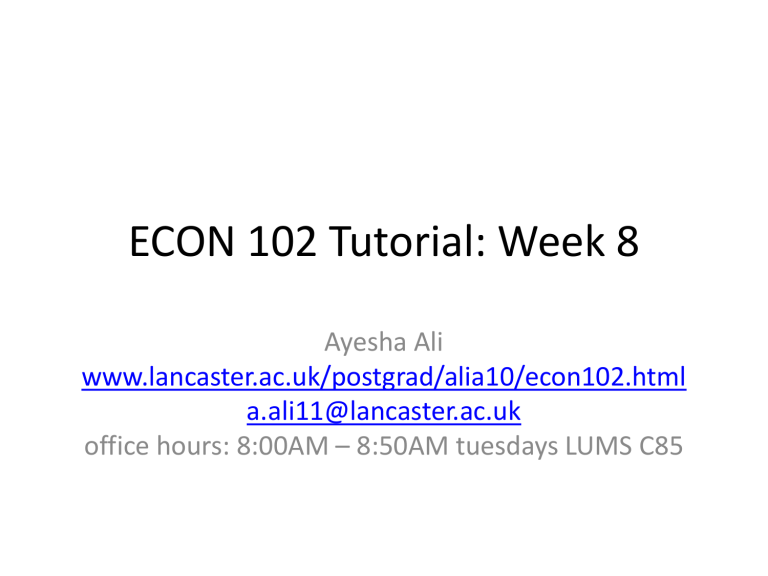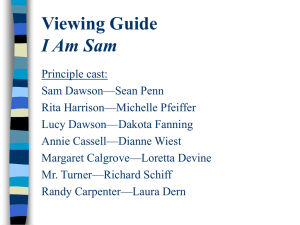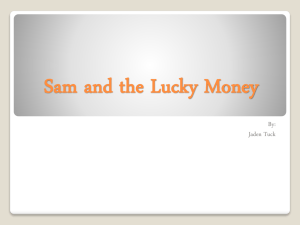ECON 102 Tutorial: Week 8
advertisement

ECON 102 Tutorial: Week 8 Ayesha Ali www.lancaster.ac.uk/postgrad/alia10/econ102.html a.ali11@lancaster.ac.uk office hours: 8:00AM – 8:50AM tuesdays LUMS C85 In-class activity: modelling a game in normal form and in extensive form Let’s watch one of the following videos of a game played on television and model it as a normal form game, and then as an extensive form game. Pay attention at the beginning while the host explains the rules of the game, we’ll need to know those in order to model it. Question 1(a) In studying for his Economics final, Sam is concerned about only two things: his grade and the amount of time he spends studying. A good grade will give him a benefit of 20; an average grade, a benefit of 5; and a poor grade, a benefit of 0. By studying a lot, Sam will incur a cost of 10; by studying a little, a cost of 6. Moreover, if Sam studies a lot and all other students study a little, he will get a good grade and they will get poor ones. But if they study a lot and he studies a little, they will get good grades and he will get a poor one. Finally, if he and all other students study for the same amount of time, everyone will get average grades. Other students share Sam’s preferences regarding grades and study time. Model this situation as a two-person prisoner’s dilemma in which the strategies are to study a little and to study a lot, and the players are Sam and all other students. Include the payoffs in the matrix. Question 1(a) In studying for his Economics final, Sam is concerned about only two things: his grade and the amount of time he spends studying. A good grade will give him a benefit of 20; an average grade, a benefit of 5; and a poor grade, a benefit of 0. By studying a lot, Sam will incur a cost of 10; by studying a little, a cost of 6. Moreover, if Sam studies a lot and all other students study a little, he will get a good grade and they will get poor ones. But if they study a lot and he studies a little, they will get good grades and he will get a poor one. Finally, if he and all other students study for the same amount of time, everyone will get average grades. Other students share Sam’s preferences regarding grades and study time. Model this situation as a two-person prisoner’s dilemma in which the strategies are to study a little and to study a lot, and the players are Sam and all other students. Include the payoffs in the matrix. First, let’s draw the payoff matrix. We have two players – Sam and All Others. Each player has two choices – Study a lot and Study a little. In order to write in the payoffs, we will write down All Others’ payoff first, then Sam’s payoff, like this: (All Others’ payoff, Sam’s payoff), for each box in the matrix. Question 1(a) In studying for his Economics final, Sam is concerned about only two things: his grade and the amount of time he spends studying. A good grade will give him a benefit of 20; an average grade, a benefit of 5; and a poor grade, a benefit of 0. By studying a lot, Sam will incur a cost of 10; by studying a little, a cost of 6. Moreover, if Sam studies a lot and all other students study a little, he will get a good grade and they will get poor ones. But if they study a lot and he studies a little, they will get good grades and he will get a poor one. Finally, if he and all other students study for the same amount of time, everyone will get average grades. Other students share Sam’s preferences regarding grades and study time. Model this situation as a two-person prisoner’s dilemma in which the strategies are to study a little and to study a lot, and the players are Sam and all other students. Include the payoffs in the matrix. Ok, so we’ve already drawn the payoff matrix. Now we are going to write down the payoffs for each player, for each choice. This example is a little more complex because we gain a benefit from the grade received, and also incur a cost from how much we study. So let’s start with Sam’s costs. Cost = 10 Cost = 10 Cost = 6 Cost = 6 Question 1(a) Instudying studyingfor forhis hisEconomics Economicsfinal, final,Sam Samisisconcerned concernedabout aboutonly onlytwo twothings: things:his hisgrade grade In andthe theamount amountof oftime timehe hespends spendsstudying. studying.AAgood goodgrade gradewill willgive givehim himaabenefit benefitof of20; 20; and anaverage averagegrade, grade,aabenefit benefitof of5;5;and andaapoor poorgrade, grade,aabenefit benefitof of0.0.By Bystudying studyingaalot, lot,Sam Sam an willincur incuraacost costof of10; 10;by bystudying studyingaalittle, little,aacost costof of6.6.Moreover, Moreover,ififSam Samstudies studiesaalot lotand and will allother otherstudents studentsstudy studyaalittle, little,he hewill willget getaagood goodgrade gradeand andthey theywill willget getpoor poorones. ones.But But all theystudy studyaalot lotand andhe hestudies studiesaalittle, little,they theywill willget getgood goodgrades gradesand andhe hewill willget getaapoor poor ififthey one.Finally, Finally,ififhe heand andall allother otherstudents studentsstudy studyfor forthe thesame sameamount amountof oftime, time,everyone everyonewill will one. get average grades. Other students share Sam’s preferences regarding grades andstudy study get willaverage get average grades. grades. Other Other students students share share Sam’s Sam’s preferences preferences regarding regarding grades grades and and time. time. study time. We know about their costs, so now let’s look at the benefits that they get from studying. Let’s look at the scenario where Sam studies a lot and All others study a little. He will get a good grade, which gives him a benefit of 20, and others get a poor grade, which has a benefit of 0. The amount of studying costs Sam 10, and costs all others 6. So the payoff for Sam is the benefit if his good grade minus the cost of studying a lot, 10, and for all others is -6. We can write this in our payoff matrix like this: Cost = 6 Cost = 10 Cost = 10 (-6, 10) Cost = 6 Next, we do this same calculation for each of the other three scenarios: where Sam and Others study a lot, where Sam and Others study a little, and where Others study a lot and Sam studies a little. Question 1(a) In studying for his Economics final, Sam is concerned about only two things: his grade and the amount of time he spends studying. A good grade will give him a benefit of 20; an average grade, a benefit of 5; and a poor grade, a benefit of 0. By studying a lot, Sam will incur a cost of 10; by studying a little, a cost of 6. Moreover, if Sam studies a lot and all other students study a little, he will get a good grade and they will get poor ones. But if they study a lot and he studies a little, they will get good grades and he will get a poor one. Finally, if he and all other students study for the same amount of time, everyone will get average grades. Other students share Sam’s preferences regarding grades and study time. Our payoff matrix should end up looking like this: Question 1(b) What is the equilibrium outcome in this game? From the students’ perspective, is it the best outcome? To find the equilibrium, we need to find each party’s best response given what the other party chooses. Here’s how to do it: Let’s say that All Others decide to Study a lot. Now, let’s look at Sam’s the Payoffs that Sam has to choose between. He can choose to Study a lot, and get a benefit of -5, or Study a little and get a benefit of -6. -5 is less bad, and therefore better, than -6, so we’ll underline that. So now we know that if All Others Study a lot, Sam will also Study a lot. We can do the same exact steps to see what Sam would do if All Others decide to Study a little. He has to choose between 10 and -1, so he would choose a payoff of 10. So, now we know that no matter what All Others does, Sam will choose to Study a lot. This means Study a lot is a dominant strategy for Sam (because he will do it regardless of what the other player does). Question 1(b) What is the equilibrium outcome in this game? From the students’ perspective, is it the best outcome? Now let’s see what All Others would do if Sam chooses to Study a lot. We’ll cover up his other option. So, now we want to know about the payoffs that All Others have to choose between, so we’ll cover up Sam’s Payoffs, because All Others only cares about it’s own payoffs. Others has to choose between a payoff of -5 and a payoff of -6. -5 is less bad, so Others will choose -5. We underline that. We’ll do the same steps again, but assume that Sam instead chooses to Study a little. We compare Others’ payoffs if Sam Studies a little. Others will choose to receive a payoff of 10, because 10 is better than -1. So, we underline 10. Now we know that Others will choose to Study a lot regardless of what Sam does. This strategy is a dominant strategy. Question 1(b) What is the equilibrium outcome in this game? From the students’ perspective, is it the best outcome? Ok, so now we have the payoffs for each player’s choices given what the other would do underlined. If there is box where both payoffs are underlined, that is the Nash Equilibrium. It represents both player’s best responses, regardless of what the other would do. So, the equilibrium outcome is that all study a lot and all receive an average grade. From the students’ perspective, for everyone to study a little would have been better. Note: This is a prisoner’s dilemma. Question 2 Consider the following “dating game”, which has two players, A and B, and two strategies, to buy a cinema ticket or a football ticket. The payoffs (A, B), given in points, are as shown in the matrix below. Assume that A and B buy their tickets separately and simultaneously. Each must decide what to do knowing the available choices and payoffs but not what the other has actually chosen. Each player believes the other to be rational and self-interested. Question 2(a) Consider the following “dating game”, which has two players, A and B, and two strategies, to buy a cinema ticket or a football ticket. The payoffs (A, B), given in points, are as shown in the matrix below. Assume that A and B buy their tickets separately and simultaneously. Each must decide what to do knowing the available choices and payoffs but not what the other has actually chosen. Each player believes the other to be rational and self-interested. Does either player have a dominant strategy? There is no dominant strategy. The best choice for each player depends on what the other player does. Question 2(b) Consider the following “dating game”, which has two players, A and B, and two strategies, to buy a cinema ticket or a football ticket. The payoffs (A, B), given in points, are as shown in the matrix below. Assume that A and B buy their tickets separately and simultaneously. Each must decide what to do knowing the available choices and payoffs but not what the other has actually chosen. Each player believes the other to be rational and self-interested. How many potential equilibria are there? The top-left and bottom-right cells are both potential equilibria. In each of those cells, neither player has any incentive to change strategies. Question 2(c) Consider the following “dating game”, which has two players, A and B, and two strategies, to buy a cinema ticket or a football ticket. The payoffs (A, B), given in points, are as shown in the matrix below. Assume that A and B buy their tickets separately and simultaneously. Each must decide what to do knowing the available choices and payoffs but not what the other has actually chosen. Each player believes the other to be rational and self-interested. Is the game a prisoner’s dilemma? Explain. The payoffs do not follow the pattern associated with a prisoner’s dilemma, because neither player has a dominant strategy. Question 2(d) Consider the following “dating game”, which has two players, A and B, and two strategies, to buy a cinema ticket or a football ticket. The payoffs (A, B), given in points, are as shown in the matrix below. Assume that A and B buy their tickets separately and simultaneously. Each must decide what to do knowing the available choices and payoffs but not what the other has actually chosen. Each player believes the other to be rational and self-interested. Suppose player A gets to buy her ticket first. Player B does not observe A’s choice but knows that A chose first. Player A knows that player B knows she chose first. What is the equilibrium outcome? A knows that if he has the first move and buys a cinema ticket, so will B, in which case A will get a payoff of 2. If A buys a football ticket, so will B, in which case A will get a payoff of 3. So A will buy a football ticket, and so will B. Question 2(e) Consider the following “dating game”, which has two players, A and B, and two strategies, to buy a cinema ticket or a football ticket. The payoffs (A, B), given in points, are as shown in the matrix below. Assume that A and B buy their tickets separately and simultaneously. Each must decide what to do knowing the available choices and payoffs but not what the other has actually chosen. Each player believes the other to be rational and self-interested. Suppose the situation is similar to part (d), except that player B chooses first. What is the equilibrium outcome? If B has the first move, they will both see a movie. Question 3 – Original Blackadder and Baldrick are rational, self-interested criminals imprisoned in separate cells in a dark medieval dungeon. They face the prisoner’s dilemma displayed in the matrix below (payoffs are Blackadder, Baldrick). Assume that Blackadder is willing to pay £1,000 for each year by which he can reduce his sentence below 20 years. A corrupt jailer tells Blackadder that before he decides whether to confess or deny the crime, he can tell him Baldrick’s decision. How much is this information worth to Blackadder? Note: There was an error in the Deny, Deny payoff in this game. Using these payoffs here, this game is not actually a prisoner’s dilemma. Question 3 -- Typo corrected Blackadder and Baldrick are rational, self-interested criminals imprisoned in separate cells in a dark medieval dungeon. They face the prisoner’s dilemma displayed in the matrix below (payoffs are Blackadder, Baldrick). Note: the payoffs in this game are supposed to represent the number of years in jail each person receives. So -1 means one year in jail, etc. Assume that Blackadder is willing to pay £1,000 for each year by which he can reduce his sentence below 20 years. A corrupt jailer tells Blackadder that before he decides whether to confess or deny the crime, he can tell him Baldrick’s decision. How much is this information worth to Blackadder? The information is worth nothing to Blackadder, who knows that Baldrick’s dominant strategy is to confess. In any case, Blackadder also has a dominant strategy of his own (also to confess). Question 4 (a) You are sitting in your car in a university car park that is currently full, waiting for a place to become free. Just as one becomes free a driver who has just arrived overtakes you in order to park in the vacated spot before you can. Suppose this driver would be willing to pay up to £10 to park in that spot, and up to £30 to avoid getting into an argument with you. At the same time the other driver guesses, accurately, that you too would be willing to pay up to £30 to avoid a confrontation, and up to £10 to park in the vacant spot. Model this situation as a two-stage decision tree in which the other driver’s bid to take the space is the opening move and your strategies are (1) to protest and (2) not to protest. If you protest (initiate an argument), the rules of the game specify that the other driver has to let you take the space. Show the payoffs at the end of each branch of the tree. Question 4 (a) You are sitting in your car in a university car park that is currently full, waiting for a place to become free. Just as one becomes free a driver who has just arrived overtakes you in order to park in the vacated spot before you can. Suppose this driver would be willing to pay up to £10 to park in that spot, and up to £30 to avoid getting into an argument with you. At the same time the other driver guesses, accurately, that you too would be willing to pay up to £30 to avoid a confrontation, and up to £10 to park in the vacant spot. Model this situation as a two-stage decision tree in which the other driver’s bid to take the space is the opening move and your strategies are (1) to protest and (2) not to protest. If you protest (initiate an argument), the rules of the game specify that the other driver has to let you take the space. Show the payoffs at the end of each branch of the tree. Question 4 (b) You are sitting in your car in a university car park that is currently full, waiting for a place to become free. Just as one becomes free a driver who has just arrived overtakes you in order to park in the vacated spot before you can. Suppose this driver would be willing to pay up to £10 to park in that spot, and up to £30 to avoid getting into an argument with you. At the same time the other driver guesses, accurately, that you too would be willing to pay up to £30 to avoid a confrontation, and up to £10 to park in the vacant spot. What is the equilibrium outcome? The top branch at A is unattractive to the other driver. Since you get a higher payoff on the bottom branch at B, and the other driver knows it, the equilibrium outcome is that he gets the space and you keep waiting. Question 5 The owner of a thriving business wants to hire someone who will manage a new office in a distant city honestly. He can afford to pay a weekly salary of £2,000 (£1,000 more than the manager would be able to earn elsewhere), and still earn an economic profit of £800. He fears that he will not be able to monitor the behaviour of the manager, who will therefore be in a position to embezzle money from the business. The owner knows that if the remote office is managed dishonestly, the manager can “earn” £3,100 while causing the owner an economic loss of £600 per week. If the owner believes that all managers are narrowly self-interested income maximisers, will he open the new office? Question 5 The owner of a thriving business wants to hire someone who will manage a new office in a distant city honestly. He can afford to pay a weekly salary of £2,000 (£1,000 more than the manager would be able to earn elsewhere), and still earn an economic profit of £800. He fears that he will not be able to monitor the behaviour of the manager, who will therefore be in a position to embezzle money from the business. The owner knows that if the remote office is managed dishonestly, the manager can “earn” £3,100 while causing the owner an economic loss of £600 per week. If the owner believes that all managers are narrowly self-interested income maximisers, will he open the new office? The owner knows that if he opens the remote office (top branch at A), the potential manger’s best strategy is to be dishonest (bottom branch at B), in which case the owner will get -£600. Since the owner gets nothing by choosing the bottom branch at A, he will not open the new office. Question 5 Suppose the owner knows that a managerial candidate is a devoutly religious person who condemns dishonest behaviour and who would be willing to pay up to £15,000 to avoid the guilt she would feel if she were dishonest. Will the owner open the remote office? If the manager is devoutly religious, then the owner will open the remote office. This time, the potential manager’s payoff on the bottom branch at B is £3,100 - £15,000 = -£11,900, so the owner knows the manager will choose the top branch at B. Question 6 (a) You are playing a game of “matching pennies” with a friend. Each of you has a penny hidden in your hand, facing either heads up or tails up (you know which way the one in your hand is facing). On the count of “three” you simultaneously show your pennies to each other. If the face-up side of your coin matches the face-up side of your friend’s coin, you get to keep the two pennies. If the faces do not match, your friend gets to keep the pennies. Who are the players in this game? What are each player’s strategies? Construct a payoff matrix for the game. The players are you and your friend. Your strategy choices are heads or tails. The following matrix describes the payoffs (you, your friend), measured as the change in the number of pennies each player owns. Question 6 (b) and (c) Is there a dominant strategy? If so, what? Is there an equilibrium? If so, what? There are no dominant strategies and there is no equilibrium, because if your friend plays one side, you want to match that side. But if you match, your friend will want to change strategies. Next Week If you have read through Chapter 9 and still found this week’s material a bit challenging, the following two videos might be helpful. Work through the week 9 worksheet and bring your completed work and any questions that you have. We’ll try to do some more maths problems.








